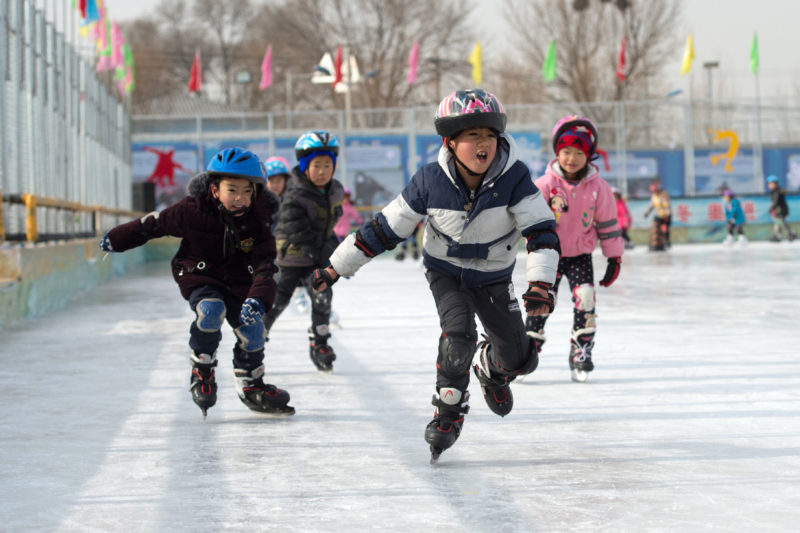China’s ice and snow sports equipment industry enters fast track of development
By Fan Jiayuan, Ji Fang, People’s Daily

China’s ice and snow sports equipment industry has overcome technology bottlenecks and embraced leapfrog development since the preparations for the Beijing 2022 Olympic and Paralympic Winter Games.
While venues empowered by sci-tech innovations for the Beijing 2022 have been constructed one after the other, the country’s first homemade snowcat and snowboard waxing vehicle have come into being. Chinese-made snowmakers, smart ski simulators, and ropeways have been widely used at ski resorts across the country.
The country’s first homemade snowcat SG400, developed by Hebei Xuanhua Construction Machinery Co., Ltd., has been employed at the Wanlong ski resort in Chongli district, Zhangjiakou city, north China’s Hebei province.
At present, the world’s snowcat market is dominated by a German manufacturer and an Italian company. Against such a backdrop, Hebei Xuanhua Construction Machinery Co., Ltd., taking the 2022 Olympic and Paralympic Winter Games as an opportunity to make innovations, started to develop snowcats independently with its rich experience in track-laying vehicle R&D and manufacturing.
Representing the first batch of high-end and high-horsepower snowcats in China, the SG400 snowcat has filled a gap in the field of the country, according to Wen Xiaoxuan, chief designer of the equipment, adding that the company owns independent intellectual property rights to key and core technologies involved in the production of the snowcat, including chassis suspension, electronic control system and hydraulic transmission.
At a cross-country skiing resort in Wenquan county, northwest China’s Xinjiang Uygur autonomous region, a snowboard waxing vehicle, the country’s first homemade vehicle of the kind, has been used for the training of the national cross-country skiing team of China.
Inside the vehicle developed by several companies from east China’s Shandong province, six snowboard waxers worked at workbenches equipped with ventilators. About one hour later, freshly waxed snowboards were handed to skiers of the team.
In the past, Chinese skiing teams had their snowboards waxed before competitions at waxing tables beside the venue or in temporary tents. The newly developed snowboard waxing vehicle has not only made the procedure efficient, but can provide a variety of other services for athletes, including helping with warm-ups and offering devices for watching live matches.
The vehicle integrates solar photovoltaic power generation, energy storage, 5G industrial Internet, big data, and AI, said An Zetao, head of the vehicle’s crew, adding that 66 patents were applied for during its designing and R&D.
China’s first homemade snowcat and snowboard waxing vehicle, while signaling the country’s technological advances, mirrors the efforts of its ice and snow sports equipment industry to break away from dependence upon imports.
Encouraged by a whole package of measures rolled out by the government, Chinese manufacturers of ice and snow sports equipment have intensified efforts to promote R&D, continuously increasing the substitution of imports with domestic ice and snow sports equipment as well as the market shares of homemade products.
As China steps forward toward the goal of “get 300 million people involved in winter sports”, its ice and snow sports equipment industry has without doubt gotten on an express train.
In 2019, the number of newly-adopted homemade snowmaking machines in China’s ski resorts rose to 467, compared with 50 in 2015, and the gap between newly-employed homemade snowmakers and imported ones was further narrowed, according to a white paper on China’s skiing industry.
As Chinese consumers’ demands for ice and snow sports surge, enterprises have increased input into the ice and snow sports equipment market, which is bound to drive the explosive growth of ice and snow sports equipment manufacturing, industry insiders pointed out.
The environment for the development of the industry has also been constantly improved in China.
Zhangjiakou has planned and constructed two large-scale ice and snow sports equipment R&D and manufacturing clusters, i.e., a winter sports equipment industrial park in Zhangjiakou High-tech Industrial Development Zone and another in its Xuanhua district, striving for building a national winter sports equipment manufacturing base and forming an industrial base integrating the R&D, design, manufacturing, testing, circulation, and storage of ice and snow sports equipment.
Data suggest that as of the beginning of 2021, Zhangjiakou had signed 81 ice and snow industry-related projects, among which 69 had been implemented, with a total investment of over 33.4 billion yuan ($5.23 billion). Thirty-one of these projects had been put into operation, creating an output value of more than 2.4 billion yuan.
Although China is a latecomer in ice and snow sports and the country’s ice and snow sports equipment industry lags behind that of many countries for the time being, it is still one of the most promising ice and snow markets in Asia and even the world, according to an official with China’s Ministry of Industry and Information Technology, who believes that Chinese manufacturers of winter sports equipment should try to identify gaps in the market and realize differentiated competition with products that can better satisfy demands of the Chinese market.












